The lawn is the foundation of suburban American landscapes and the pride and joy of (almost) every homeowner.
But maintaining that luxurious lawn can be a pain and time drain.
- Weekends mowing and edging the grass
- Time wasted watering, weeding, and fertilizing
- Multiple trips to the hardware store for never-ending lawn care supplies
Wouldn’t you rather kick back, crack open a cool one, and enjoy the game?
There’s an easier way, like adjusting the mower to its highest setting and leaving the clippings for mulch. Have you tried that? Less raking, fertilizing, and weeding are just a few of the benefits.
In this blog, we’ll explore simple tricks and techniques for keeping your lawn dapper in less time and with a fraction of the effort you’re investing today.
Tip 1: Mowing & Mulching
Try mowing grass three inches high with a mulching attachment on the self-propelled mower. The “Don’t Bag It Lawn Care Plan” saves considerable time.
- The taller grass provides more shade for the grass and soil.
- It reduces the risk of disease, insects, and weeds and lowers soil temperatures.
- The taller grass plants have a larger and deeper root system. They’re more vigorous and drought-tolerant.
The clippings are smaller and forced into the grass. Elements in the clippings are recycled, saving about one-third on fertilizers.
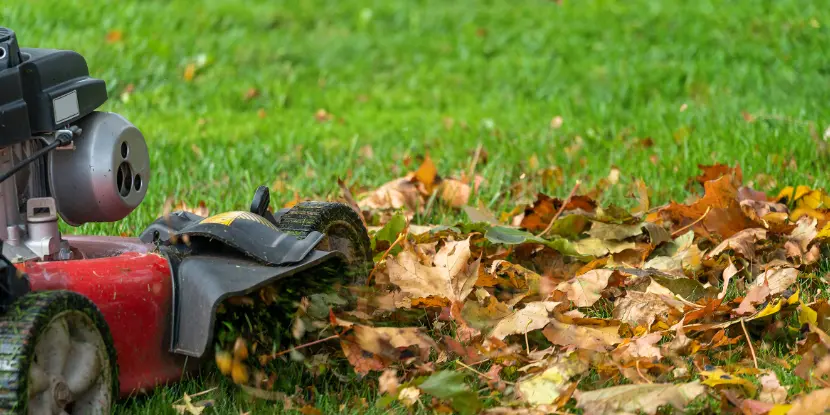
A mulching mower is a homeowner’s best friend and a BIG time-saver.
Gypsum Soil Treatments
- Applying gypsum to the lawn soil can reduce the need for commercial fertilizer.
- It’s also the best thing to do for the lawn when you have clay soil.
- The gypsum should loosen clay soil so more water and nutrients soak down.
Tip 2: Smart Watering
- Allow the soil to dry to about a depth of one to two inches before you water again.
- This encourages the grass roots to penetrate deeper into the soil, making the plants more resilient and drought-tolerant.
- To measure soil dryness, push a screwdriver or finger into the soil to feel the moisture level. If it feels dry and hard to push in, it’s time to water.
- By not overwatering, you also discourage shallow root growth and reduce the chances of diseases and pests taking hold in your lawn.
- Water your lawn in the morning. The water soaks down deeper and needs to be applied less often.

Water your lawn in the morning. The water soaks down deeper and needs to be applied less often
Also…
- Consider switching to drought-resistant grass species like Bermuda or Zoysia grass. These types of grass require less water and maintenance than traditional turfgrass varieties.
- Install an irrigation system with smart technology that adjusts watering based on weather conditions and soil moisture levels. This can save time by eliminating the need to adjust sprinkler settings manually.
- Collect rainwater for your lawn using rain barrels or other rainwater harvesting methods instead of relying solely on municipal water sources.
- Incorporate natural elements into your lawn, such as rocks, mulch, and native plants, which require less maintenance and can add a distinct aesthetic to your yard.
Tip 3: Aerating
Aerate your lawn occasionally with a plugging machine. This facilitates water and fertilizer entering the root zone and encourages a deeper root system.
Depending on soil compaction and traffic, aerate your lawn once or twice a year. Regular aeration reduces the need for extensive treatments later.
- Aerate during the growing season when your grass can recover quickly. Early spring or fall is ideal for cool-season grasses, and late spring or early summer works best for warm-season grasses.
- Consider renting or buying a powered aerator to save time and effort compared to manual tools. These machines can cover large areas efficiently.
- Before you start, mark any underground utilities, sprinkler heads, or other obstacles to prevent damage during aeration.
- Aerate your lawn on the same day as other maintenance tasks, such as fertilizing or overseeding, to ensure seeds and nutrients reach the soil.
- Aerate systematically, working back and forth across your lawn in straight lines for complete coverage.
- Lightly water your lawn the day before aerating. Moist soil is easier to aerate and helps the tines penetrate deeper.
- Leave soil cores on the lawn after aerating. They will break down naturally and improve soil structure over time.
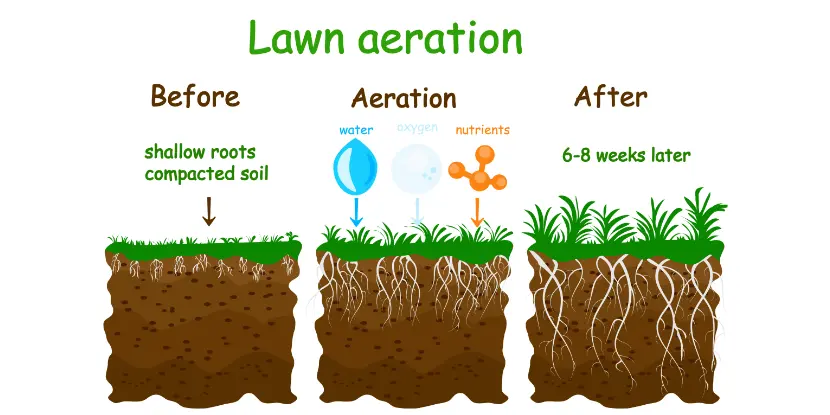
Aerating your lawn at least once a year promotes vigorous root growth.
Tip 4: Fertilizing
- Opt for slow-release fertilizers that provide nutrients over an extended period. This reduces the frequency of application and ensures a steady supply of nutrients.
- Conduct a soil test to identify nutrient deficiencies and tailor your feeding plan accordingly. This avoids over-fertilizing and saves time and money by targeting only what your lawn needs.
- Apply fertilizer in the fall to promote root growth over the winter. This will lead to a healthier lawn in the spring and reduce the need for fertilizing during the growing season.
- Combine fertilizing with other maintenance tasks like aerating or over-seeding. This enables better nutrient absorption and reduces the time needed to work on your lawn.
- Invest in a broadcast spreader to evenly distribute fertilizer across your lawn. This ensures quick and consistent coverage.
- Organic fertilizers require less frequent application and improve soil health over time, making future maintenance easier.
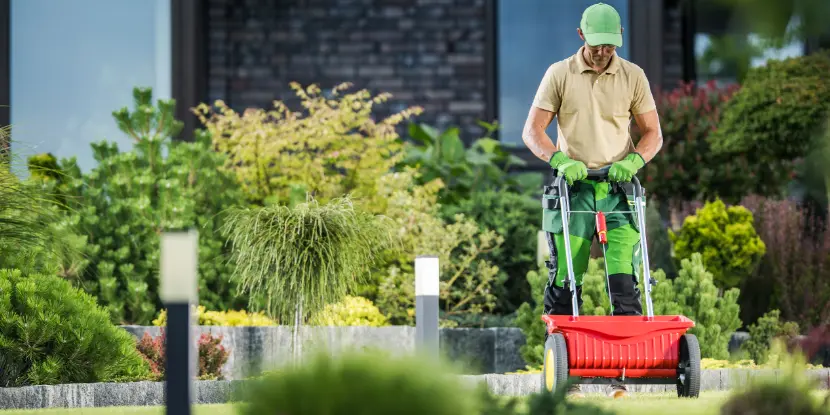
Invest in a good fertilizer spreader to save time and ensure even coverage.
Tip 5: Dealing with Pests
- Regularly inspect your lawn for signs of pests like grubs, chinch bugs, or armyworms. Early detection allows for prompt action and reduces the need for extensive treatments.
- Encourage natural predators like birds, beneficial insects, and nematodes to visit your yard. They can help keep pest populations in check.
- Manage pests using organic solutions like neem oil or diatomaceous earth. These options are environmentally safe and can be applied quickly and easily.
- Incorporate pest-repelling companion plants like marigolds, garlic, or rosemary into your lawn or garden design. These plants naturally deter common pests.
- Maintain a healthy lawn through proper mowing, watering, and fertilizing. Robust grass is more resistant to pest infestations.
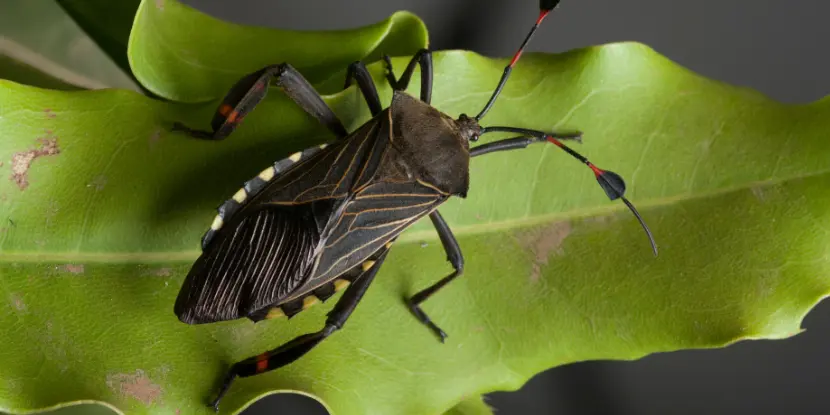
Chinch bugs are among the most destructive lawn pests.
Tip 6: Controlling Weeds
- Keep grass at an optimal height to shade out weed growth. The general rule is to cut only one-third of the grass blade length at a time.
- Hand-pull weeds when they’re young and before they can spread seeds. This reduces the need for herbicides and prevents future weed growth.
- Use natural, non-toxic herbicides. They can be as effective as chemical options but are safer for your lawn and the environment.
- Improve soil health through proper maintenance practices like aerating, fertilizing, and watering. Healthier grass can more effectively outcompete weeds.
- Overseed with dense turfgrass varieties to fill in bare spots and crowd out weeds. This will also help improve the overall appearance and health of your lawn.
- Apply a thick layer of organic mulch like straw, grass clippings, or wood chips. This suppresses weed growth by blocking sunlight.
- Spread corn gluten meal on your lawn as a natural pre-emergent herbicide. It prevents weed seeds from germinating.
- Use a vinegar-based spray to target and kill unwanted weeds. This is especially effective on young, tender weeds.

Hand pull weeds before they go to seed and spread. Sorry, no dandelion fluff (unless you’re growing plants for tea)!
Bonus Tip: Xeriscaping
Xeriscaping features drought-tolerant plants, efficient irrigation techniques, and soil enhancements to create sustainable, low-maintenance landscapes.
Derived from the Greek word “xeros,” meaning dry, xeriscaping is particularly beneficial for areas prone to water scarcity, such as the Southwestern United States.
By integrating xeriscaping principles, homeowners can achieve an attractive and sustainable garden with a fraction of the upkeep required by traditional lawns.
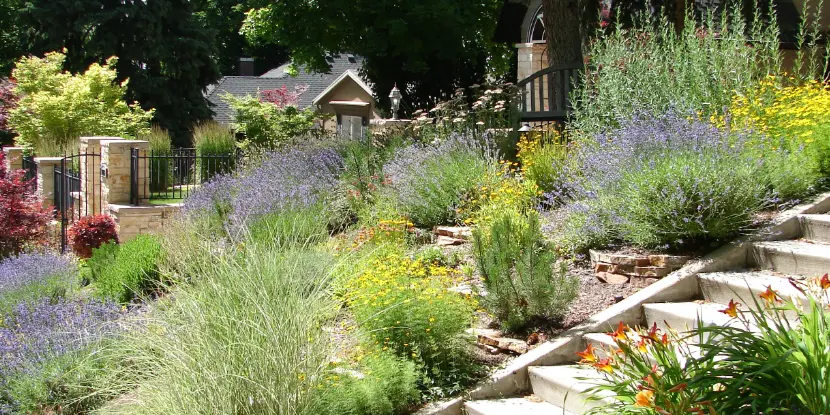
Xeriscaping replaces high-maintenance vegetation with tough, drought-resistant, and often native plants.
Reasons Xeriscaping Reduces Maintenance Time
- Drought-tolerant plants require minimal watering and tend to be hardy.
- Drip irrigation systems deliver water directly to the plant roots, reducing water waste and the need for frequent adjustments.
- Adding mulch and compost improves soil health and moisture retention, lessening the frequency of watering and fertilizing.
- With fewer grassy areas, the need for regular mowing is minimized, saving time and effort.
- Dense planting and mulch layers suppress weed growth, reducing the need for weeding or herbicide application.
- Native and drought-resistant plants need less fertilizer.
FAQs: Lawn Care Tips
Q: Is it possible to have a low-maintenance, aesthetically pleasing lawn?
Absolutely! Following the tips outlined above and incorporating xeriscaping principles, you can achieve a beautiful and sustainable lawn with minimal upkeep.
Q: How often should I mow my lawn for optimal maintenance?
The general rule is to only cut one-third of the grass blade length at a time. This equates to mowing once every 1–2 weeks during peak growing season.
Q: Can I use chemicals on my lawn if I want it to be low-maintenance?
Chemical treatments seem like an easy solution, but they can disrupt your lawn’s natural balance. Choose organic and natural alternatives that are safer for your lawn and the planet.
Additionally, incorporating xeriscaping principles can reduce the need for chemical treatments.
Q: Is it necessary to water my lawn during drought conditions?
Prioritize watering your plants and trees over your lawn. If you must water your lawn, drip irrigation systems or hand-watering specific areas can be more efficient than traditional sprinklers. Selecting native and drought-resistant plants as part of a xeriscaping plan can significantly decrease the need for watering.
Q: What type of grass is best suited for a low-maintenance lawn?
Turfgrasses like Bermuda grass, Zoysia grass, or Buffalo grass are drought-tolerant and require less frequent mowing.
Q: How can I improve soil health to support a low-maintenance lawn?
Aerate to enhance soil structure, add organic matter like compost to increase nutrient content, and ensure proper pH levels. Healthy soil promotes robust grass growth.
Q: How can I manage fallen leaves on a low-maintenance lawn?
Rather than raking and bagging leaves, try mulching them with a mower. Mulched leaves decompose and return valuable nutrients to the soil.
Q: Are there any alternatives to traditional turfgrass for a low-maintenance lawn?
Consider lawn alternatives like ground covers: clover, thyme, creeping sedum, and more. These attractive plants require less water and mowing than traditional turfgrass.

